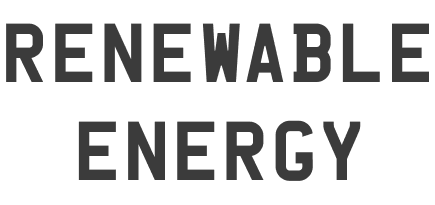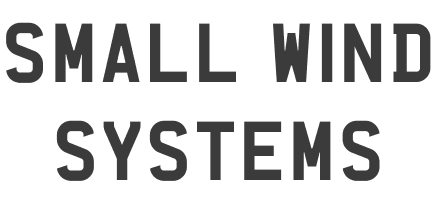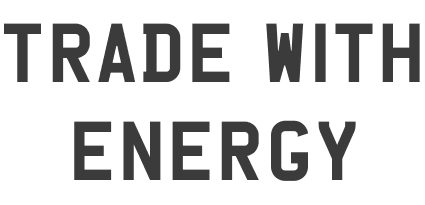- Manufacturer: quietrevolution
- Material: carbon fibre, epoxy resin
- www.quietrevolution.co.uk
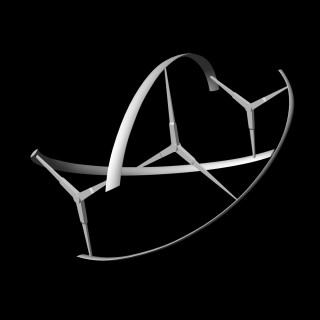
Index
- Renewable Energy There are no passengers on spaceship earth. We are all crew (Marshall McLuhan, 1964) Renewable energy is derived from an energy source that is rapidly
- Urban Wind The quietrevolution (QR) was designed in response to increasing demand for wind turbines that work well in the urban environment, where wind speeds ar
- Small Wind Systems Small wind turbines are electric generators that utilize wind energy to produce clean, emissions-free power for individual homes, farms, and small bus
- Trade With Energy German energy firm RWE Innogy has invested £6m in a London company that specialises in providing small wind turbines designed for urban areas. RWE In
- Future Energy Offshore wind power is vital for Europe's future. Offshore wind power provides the answer to Europe's energy and climate dilemma [...] Reaching 40 GW
- Risks A modern turbine typically spins at 25rpm, which translates to a few million times a year. 'Turbines have to face a lot of force,' [...] 'They are equ
There are no passengers on spaceship earth. We are all crew (Marshall McLuhan, 1964)
Renewable energy is derived from an energy source that is rapidly replaced, or renewed, by a natural process. Such renewable energy sources include wind, sun, hydropower, biological processes and geothermal processes.
Wind energy is the world's fastest-growing energy source. It is a form of solar energy as weather processes that are influenced by the sun cause wind. Windmills have been used for hundreds of years. Large and small wind turbines in many countries now generate electricity, for industry, homes and remote dwellings and villages. Wind turbines can be situated on land or off-shore. [...]
We live on a planet with all kinds of limits in an ultimately finite solar system. That is why, in theory only, there is no such thing as a straightforward division between 'renewable' and 'non-renewable' energy sources. They are renewable or non-renewable only as seen from human perspectives of limited human life-spans and needs.
Capacity
British buildings equipped with solar, wind and other micro power equipment could generate as much electricity in a year as five nuclear power stations, a government-backed industry report showed [...].
Such a large scale switch to microrenewable energy could save 30m tonnes of CO2 – the equivalent of nearly 5% of all UK electricity.
Renewable Energy Conference 2009
Professor Arthouros Zervos, EREC president, said, 'The renewable industry is providing more than 450,000 jobs and has an annual turnover exceeding €45bn. Renewable energy contributes to one quarter of the EU's 20 per cent greenhouse gas commitment and has reached a share of about 10 per cent of final energy consumption. [...] Renewable energy is the competitive advantage of Europe and the key to a sustainable 21st century economy. We have to make renewable energy the mainstream source of our energy system.'
Wind Energy
Every unit of electricity from a wind turbine displaces one from conventional power stations: in January 2009, wind turbines in the UK had the capacity to prevent the emission of 3,682,563 tonnes of carbon dioxide per annum.
Since the first wind farm in the UK was built at Delabole in 1991, onshore wind energy has established itself as a mature, clean energy generating technology. In 2007 wind energy overtook hydropower to become the largest renewable generation source, contributing 2.2% of the UK's electricity supply, with onshore wind comprising the bulk of this. Wind has been the world's fastest growing renewable energy source for the last seven years, and this trend is expected to continue with falling costs of wind energy, energy security threats and the urgent international need to tackle CO2 emissions to prevent climate change.
The quietrevolution (QR) was designed in response to increasing demand for wind turbines that work well in the urban environment, where wind speeds are lower and wind directions change frequently.
The elegant helical (twisted) design of QR ensures a robust performance even in turbulent winds. It is also responsible for virtually eliminating noise and vibration.
At five metres high and three metres in diameter, it is compact and easy to integrate, and with just one moving part, maintenance can be limited to an annual inspection.

Output
The qr5 has a peak power of over 7kW. A typical installation would generate 4000-9000 kWhr per annum, enough to supply energy to a ten person office.
In the UK, this is equivalent to displacing 2000-5000kg of annual CO 2 emissions associated with grid -generated electricity.
Vertical and Horizontal Axis Wind Turbines
Vertical Axis Wind Turbine (VAWT)
A type of wind turbine in which the axis of rotation is perpendicular to the wind stream and the ground. VAWTs work somewhat like a classical water wheel in which water arrives at a right angle (perpendicular) to the rotational axis (shaft) of the water wheel. Vertical-axis wind turbines fall into two major categories: Darrieus turbines and Savonius turbines. Neither type is in wide use today.
Horizontal Axis Wind Turbine (HAWT)
A wind turbine in which the axis of the rotor's rotation is parallel to the wind stream and the ground. All grid-connected commercial wind turbines today are built with a propeller-type rotor on a horizontal axis (i.e. a horizontal main shaft). Most horizontal axis turbines built today are two- or three-bladed, although some have fewer or more blades. The purpose of the rotor is to convert the linear motion of the wind into rotational energy that can be used to drive a generator. [...]
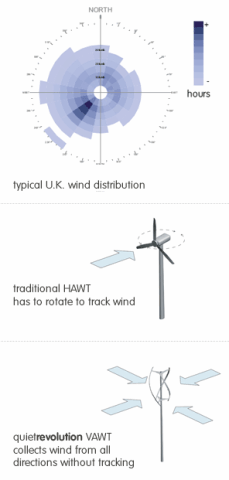
Small wind turbines are electric generators that utilize wind energy to produce clean, emissions-free power for individual homes, farms, and small businesses. With this simple and increasingly popular technology, individuals can generate their own power and cut their energy bills while helping to protect the environment. The U.S. leads the world in the production of small wind turbines, which are defined as having rated capacities of 100 kilowatts and less, and the market is expected to continue strong growth through the next decade.
Monitoring
The monitoring programme started in 2007 and specifically covered 57 sites across the UK, with the results overwhelmingly indicating that small wind systems could become a major UK renewable energy technology, generating around 3,459GWh, or around the same as UK hydro plants.
Resources
The UK has the largest wind resource of any country in Europe, making it the ideal choice for a renewable source of energy. [...]
Typically, reasons for wind turbines causing disruption or being refused planning permission include its visual impact, noise and vibration. The quietrevolution turbine's elegant design is geared towards adding visual appeal to its surroundings, and the aerodynamics of the vertical axis design mean that noise and vibration is reduced to near silence. Many planning departments in councils across the UK support quietrevolution as their preferred solution for small wind in an urban environment.
German energy firm RWE Innogy has invested £6m in a London company that specialises in providing small wind turbines designed for urban areas.
RWE Innogy, which has its headquarters in Essen, Germany, said it was providing its investment through its Venture fund, an annual £40 million spend designed to provide equity for a 'large number of promising young technology firms'. 'The purpose of our involvement,' explained Crispin Leick, head of the Ventures division, 'is to take this promising technology towards mass production, so that it will become commercially usable.'
Renewable Obligation
The Renewables Obligation (RO) obligates suppliers to source an increasing amount of energy from renewable sources and suppliers can comply with their obligations by presenting Renewable Obligation Certificates (ROCs), making a buy-out payment, or through a combination of both.
In order to meet their RO, suppliers buy ROCs off renewable energy generators. If a supplier does not buy enough ROCs and so does not meet its obligation, it has to pay a buy-out fee.
Essentially, the RO is a market mechanism.
Renewable Obligation Certificates (ROCs) are tradable certificates issued by energy regulator Ofgem to an accredited generator for eligible renewable electricity generated within the United Kingdom and supplied to customers within the United Kingdom by a licensed electricity supplier.
Desertec
12 companies today signed a Memorandum of Understanding in Munich to establish a DESERTEC Industrial Initiative (DII). The objective of this initiative is to analyse and develop the technical, economic, political, social and ecological framework for carbon-free power generation in the deserts of North Africa.
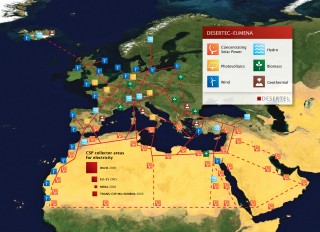
- www.desertec.org/en/press/press-releases/090713-01-assembly-desertec-industrial-initiative/
- upload.wikimedia.org/wikipedia/commons/7/71/DESERTEC-Map_large.jpg
Climate Change
In the coming decades, global developments will confront mankind with unprecedented challenges: climate change, a population growth far beyond Earth's present carrying capacity, the global striving for prosperity, and increasing demands for energy and water, are the core problems we are faced with. 200 years of global industrialization has resulted in an unparalleled standard of living and an increased life expectancy for part of the world's population. However, all this has been and is still being achieved at a price: alarming environmental destruction as well as climate change which can no longer be ignored. These things will mean dramatic changes to life on Earth in the future.
Studies by the German Aerospace Center (DLR) show that, within 40 years, solar thermal power plants in particular will be capable of generating economically more than half of the electricity needs of the EUMENA region (Europe, the Middle East, North Africa) at that time.
Offshore wind power is vital for Europe's future. Offshore wind power provides the answer to Europe's energy and climate dilemma [...]
Reaching 40 GW of offshore wind power capacity in the EU by 2020 is a challenging but manageable task. An entire new offshore wind power industry and a new supply chain must be developed on a scale that will match that of the North Sea oil and gas endeavour. However, the wind energy sector has a proven track record onshore with which to boost its confidence, and will be significantly longer lived than the oil and gas sector.
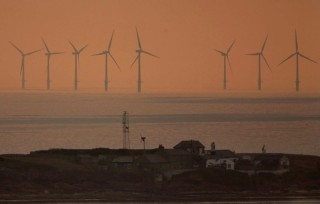
Smart Grids
A smart grid delivers electricity from suppliers to consumers using digital technology to control appliances at consumer's homes to save energy, reduce cost and increase reliability and transparency. Such a modernized electricity network is being promoted by many governments as a way of addressing energy independence, global warming and emergency resilience issues. [...]
In principle, the smart grid is a simple upgrade of 20th century power grids which generally 'broadcast' power from a few central power generators to a large number of users, to instead be capable of routing power in more optimal ways to respond to a very wide range of conditions, and to charge a premium to those that use energy at peak hours.
Partnerships
DOE's National Renewable Energy Laboratory (NREL) and Siemens flipped the switch on a new 2.3 MW wind turbine [...] as the centerpiece for a study of large land-based turbines. It is the largest partnership between government and industry undertaken to date for wind power production.
Wind energy is considered one of the top Smart Grid technologies to bring clean renewable energy into the U.S. power supply.
Siemens and NREL will test basic characteristics of the turbine and assess new performance-enhancing features of the pilot turbine over at least three years and possible longer, as dictated by their Cooperative Research and Development Agreement. The testing will incorporate a full range of real-world operating environments that includes severe weather conditions.
Energy Storage
The wind blows when and where it will, and it rarely heeds our wishes. These days, that can have a serious impact on our power supply, to which wind energy is now making an increasingly important contribution. [...]
Wind power isn't always generated exactly when consumers need it. As a rule, wind generators produce more power at night, and that's exactly when demand bottoms out. With conventional power plants, output can be adjusted in line with consumption, merely by burning more or less fuel. With fluctuating sources of energy, however, this is only possible to a limited degree. [...]
The ideal solution is to cache the surplus electricity and feed it back into the grid as required. [...]
By far the best solution is to cache the surplus electricity and then feed it back into the grid whenever the wind drops or skies are cloudy. Here, a proven method is to use pumped-storage power plants.
A modern turbine typically spins at 25rpm, which translates to a few million times a year. 'Turbines have to face a lot of force,' [...] 'They are equivalent to the lift forces faced by aircraft in takeoff, and some blades are of comparable size now to the wing of a Boeing 747.' [...]
Unlike aircraft, however, wind turbines operate in 'the lower part of the Earth's atmosphere, where it is very turbulent and wind is more interrupted. Repetitive loading of forces causes cracks. But the industry is well aware of this.' Engineers calculate the forces and add a safety margin, which is then built into the design.
www.youtube.com/watch?gl=GB&hl=en-GB&v=c3FZtmlHwcAWildlife
Birds occasionally collide with wind turbines, as they do with other tall structures such as buildings. […] No matter how extensively wind is developed in the future, bird deaths from wind energy are unlikely to ever reach as high as 1% of those from other human-related sources such as hunters, house cats, buildings, and autos.
Wind energy can also negatively impact birds and other wildlife by fragmenting habitat, both through installation and operation of wind turbines themselves and through the roads and power lines that may be needed. This has been raised as an issue in areas with unbroken stretches of prairie grasslands or of forests. More research is needed to better understand these impacts.
Visual Impact
Aesthetics have also been an issue in some areas. In the USA, the Massachusetts Cape Wind project was delayed for years partly because of aesthetic concerns. In the UK, repeated opinion surveys have shown that more than 70% of people either like, or do not mind, the visual impact. According to a town councillor in Ardrossan, Scotland, the overwhelming majority of locals believe that the Ardrossan Wind Farm has enhanced the area, saying that the turbines are impressive looking and bring a calming effect to the town. The turbines are more than 3 kilometres from the town.


















































